If you look at areas of Alaska on a map it almost looks like Swiss Cheese. That’s because there are roughly three million lakes in Alaska! Alaska’s water systems are greater than the landmass of Massachusetts and Vermont combined.
Alaska itself is a largely undeveloped area providing refuge for fish, birds, and other animals. The state is full of protected areas and massive preservations. From top to bottom, left to right there are water systems everywhere. Rivers flow down giant mountains and feed into enormous lakes.
So, what are the most interesting lakes in Alaska?
One lake is on the top of a mountain in a volcano, while another is rumored to house a giant lake monster. Alaska boasts isolated, remote lakes accessible by plane only creating bucket list style angling adventures. It was tough to choose ten lakes to focus on but here are the absolute gems we think you will find interesting and amazing.
Four Giant Lakes in Alaska
1. Becharof Lake
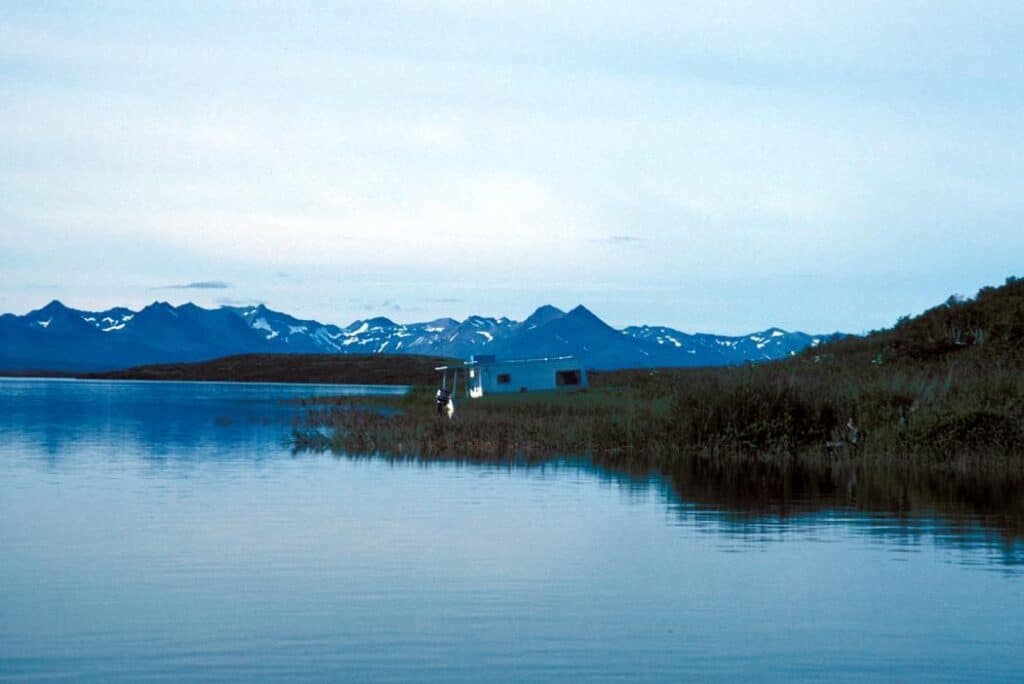
Flooded with water, and sockeye salmon, massive Becharof is a highly desired destination for anglers
©USFWS / pixnio – License
| Lake Becharof | |
|---|---|
| Surface Area | 289,920 acres |
| Max Depth | 600 feet |
- Camping/Overnight Available: Yes
- Boating/Docks: Yes
- Swimming Permitted: Yes
- Fishing Permitted: Yes
- Best For: Salmon Fishing, Brown Bear
Enjoy year-round fishing at Becharof Lake where you could catch one of the six million sockeye salmon that swim through its chilly waters. Don’t be shocked to spot a brown bear, the salmon are one of their preferred food sources.
Moose, caribou, wolverine, and fox also roam the area providing excellent photography and hunting opportunities. seals, sea lions, sea otters, eagles, and falcons are also often spotted by visitors of Becharof Lake.
Becharof Lake is the fourteenth largest lake in the United States and the Becharof National Wildlife Refuge protects 1,157,000 acres. Becharof Lake sits stop roughly 300,000 acres of the refuge.
2. Teshekpuk Lake
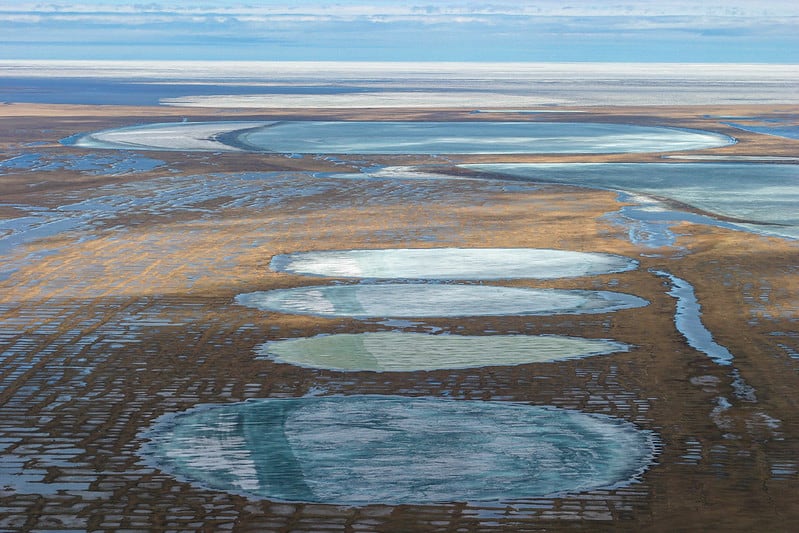
Teshekpuk Lake is home to the Teshsekpuk Lake Observatory and largest is the biggest lake in the Alaskan Arctic and the third-largest in the state of Alaska
©Bureau of Land Management Alaska / flickr – License
| Teshekpuk Lake | |
|---|---|
| Surface Area | 204,800 acres |
| Max Depth | 33 feet |
- Camping/Overnight Available: No
- Boating/Docks Available: No
- Swimming Permitted: Yes
- Fishing Permitted: Yes
- Best For: Recognized by National Audubon Society & Birdlife International
Remote Teshekpuk Lake is the largest lake in Arctic Alaska and home to a plethora of important wildlife species. The area is protected from oil drilling and provides a safe harbor for the many endangered species of birds and animals.
White-fronted, brant, Canada, and snow geese flock to the lake in the tens of thousands for molting. Teshekpuk Lake provides a sanctuary for these flightless, molting geese due to its remote location and protected areas.
Many other species on the Alaska WatchList rely on the lake to survive. The Teshekpuk Lake Special Area and other parts of the lake are off-limits for energy development. The lake gets its name from the Inupiaq word tasok-poh, which translates to “big coastal lake” or “the largest lake of all.”
3. Naknek Lake
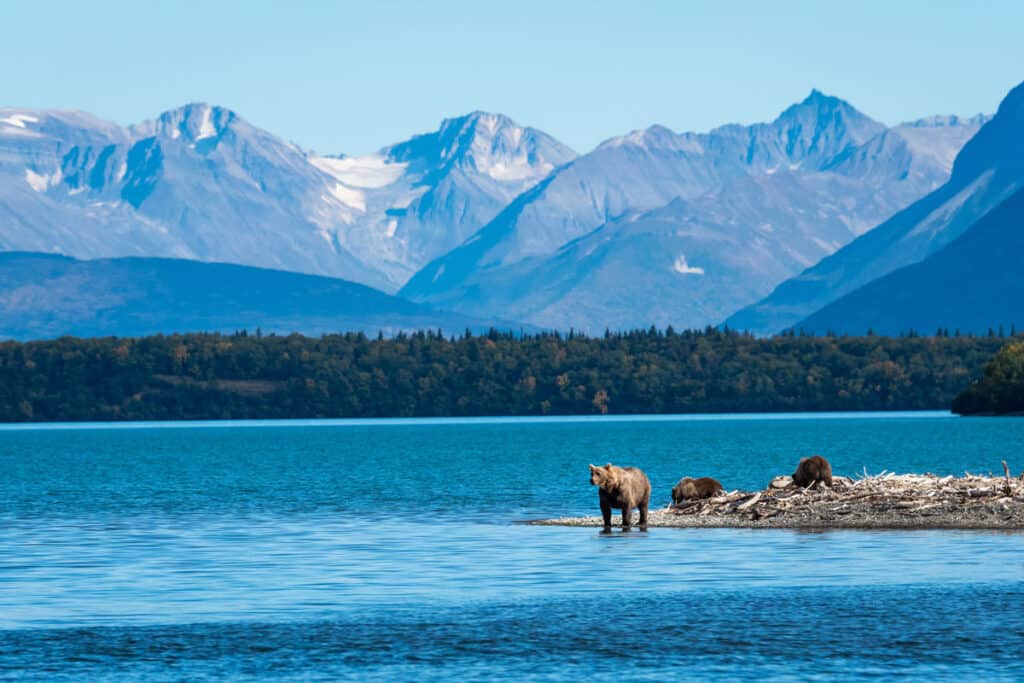
Massive fish, gigantic lake, salmon, trout, camping options are all available at magnificent Naknek Lake
©iStock.com/N8tureGrl
| Naknek Lake | |
|---|---|
| Surface Area | 150,016 acres |
| Max Depth | 568 feet |
- Camping/Overnight Available: Yes
- Boating/Docks Available: Yes
- Swimming Permitted: Yes
- Fishing Permitted: Yes (No Baitfishing Allowed)
- Best For: Sport Fishing, King & Sockeye Salmon
Located in Southern Alaska, Naknek Lake is a salmon angler’s paradise. Multiple species of salmon and other fish swarm the lake’s waters providing killer fishing opportunities. It’s not a surprise the lake got a five-star review on TripAdvisor, the public has spoken.
The Neknek River flows into the lake and this symphony creates the perfect ground for insanely huge trout and salmon of many varieties. Different species will spawn and move waters during different times of the year so be sure to do some research before heading out.
Visitors can also enjoy the amazing Katmai National Park and Preserve famous for the ash-filled Valley of Ten Thousand Smokes and brown bear population. There is a generous selection of camping options available for overnight trips to the lake.
4. Tustumena Lake

Non-road accessible and extremely isolated Tustumena Lake offers a very secluded option for avid hunters and anglers
©Own work / Creative Commons – License
| Tustumena Lake | |
|---|---|
| Surface Area | 60,000 acres |
| Max Depth | 950 feet |
- Camping/Overnight Available: Yes
- Boating/Docks Available: Yes (No Road Access)
- Swimming Permitted: Yes
- Fishing Permitted: Yes
- Best For: Exceptionally Deep Waters, Hunting, Tustumena 200 Sled Dog Race
Contained within the Kenai National Wildlife Refuge Tustumena Lake is a remote body of water accessible only by the Kasilof River. Boating is permitted on the lake but there are no roads or docks present at the lake.
Anglers can expect to catch char, dolly varden, trout, and salmon, and moose hunting is also very popular at Tustumena Lake. Camping is permitted but this isn’t a resort-style of lake experience.
The Tustumena 200 Sled Dog Race is named after Tustumena Lake. The Tustumena 200 is an annually held two hundred-mile dog sled race on the Kenai Peninsula of Alaska. The race offers a large prize and takes place on the last weekend of January.
Two Urban Lakes In Alaska
5. Auke Lake
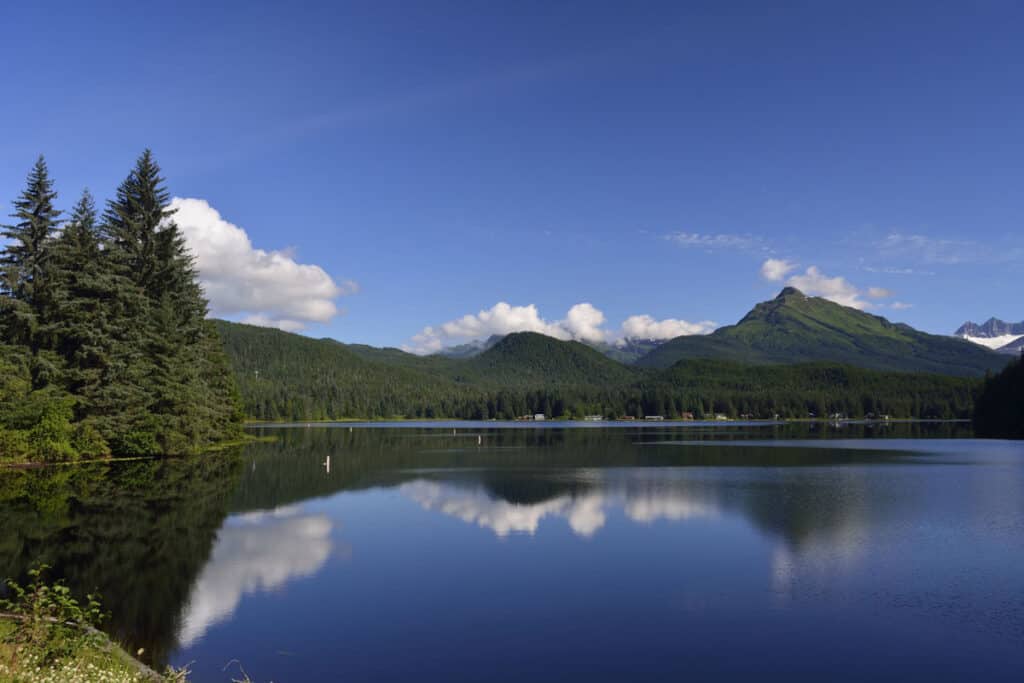
Minutes away from the airport in Juneau Auke Lake offers boating, fishing, hiking, and swimming. Get the outdoor experience basically in the city!
©iStock.com/James Cross
| Auke Lake | |
|---|---|
| Surface Area | 160 acres |
| Max Depth | 113 feet |
- Camping/Overnight Available: Yes
- Boating/Docks Available: Yes
- Swimming Permitted: Yes
- Fishing Permitted: Yes
- Best For: Outstanding Fishing, Boat Access
If you’re looking for a lake closer to the city there isn’t a better bet than Auke Lake in Juneau. This isn’t some boring body of water on the outskirts of town. Anglers can catch dolly varden, trout, tteelhead, and four varieties of salmon at Auke Lake.
Boating is also popular at Auke Lake as it’s the only lake in the area that has a boat ramp. Swimming and hiking are regularly enjoyed by travelers and city dwellers looking for an expedition that’s not too far from home.
Rainbow trout and steelhead are the most popular catches at Auke Lake. There are tons of species that frequent the waters but the sea-running spawning variety are sought and caught the most. Auke Lake is minutes from the Juneau International Airport.
6. Goose Lake
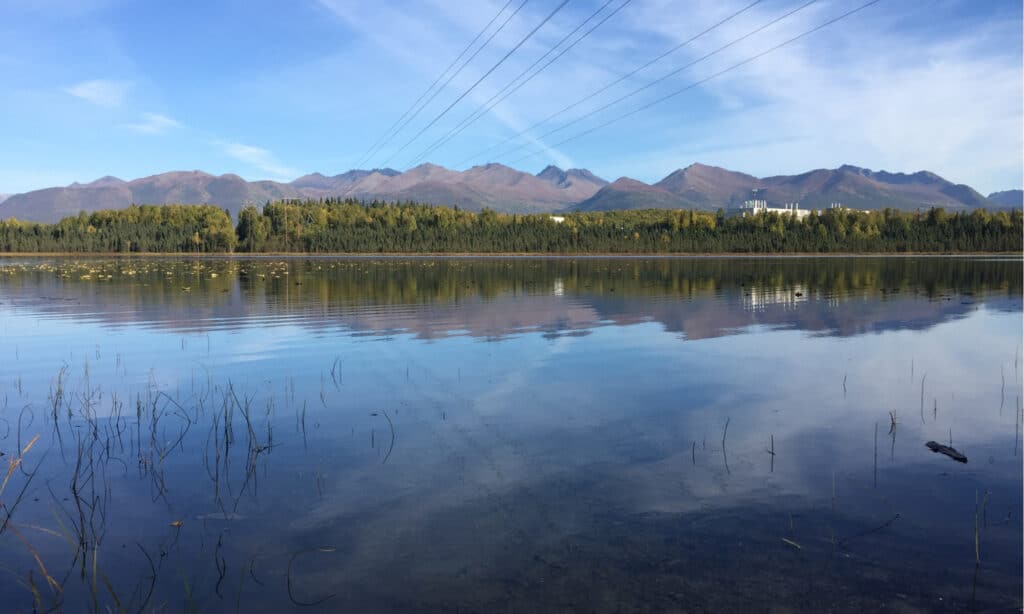
Escape to the wilderness right in the city at Goose Lake. Running, fishing and swimming are all popular activities for locals and tourists
©Joey Mendolia/Shutterstock.com
| Goose Lake | |
|---|---|
| Surface Area | 192 acres |
| Max Depth | 37 feet |
- Camping/Overnight Available: City Hotels & Motels
- Boating/Docks Available: No
- Swimming Permitted: Yes
- Fishing Permitted: Yes
- Best For: Running, Exercise, Swimming, Fishing
For locals and tourists to the city, Goose Lake offers a wonderful little outdoor atmosphere with trails, fishing, and options for swimming when the weather agrees. The lake is close to the University of Alaska Anchorage so students can stroll through the park after class if it suits them.
If you’re looking to do some in-city fishing Goose Lake doesn’t disappoint. Northern pike are pulled from the lake in addition to trout. The trout are reported to bite early in the morning on worms.
Goose Lake is essentially in the heart of Anchorage so amenities are about. Hotels, restaurants, shopping, and everything else are within minutes of the lake. If you happen to pass through Anchorage and have a minute check out Goose Lake and mark Alaska lake off your bucket list.
Alaska’s Lake In A Volcano
7. Katmai Crater Lake
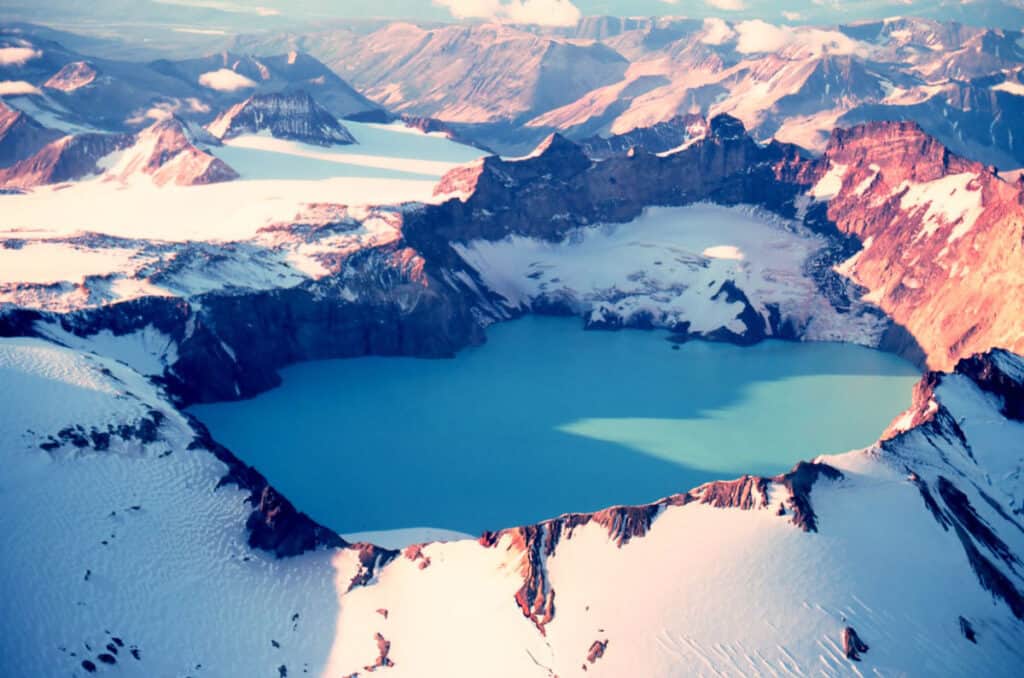
Yes, that’s a lake, in a volcano! Unbelievable Katmai Crater Lake is a pool of water in the top of a giant volcano; unreal!
©GCaptain Budd Christman, NOAA Corps / Public Domain – License
| Katmai Crater Lake | |
|---|---|
| Surface Area | N/A |
| Max Depth | 800 feet |
- Max Depth: 800 Feet
- Camping/Overnight Available: No
- Boating/Docks Available: No
- Swimming Permitted: No
- Fishing Permitted: No
- Best For: Being an Amazing Lake in a Volcano!
Probably the youngest lake on our list, Katmai Crater Lake, or Crater Lake as it’s also called, was discovered in 1916. A few years earlier in 1912, the enormous eruption of a nearby volcano caused the top of Katmai Mountain to collapse. When the area was explored after the volcanic activity settled the water-filled mountain top was discovered.
This isn’t a lake for the typical outdoor recreational activities and isn’t accessible except by flightseeing tours. It’s one of the most magnificent lakes that exist in the area and maybe even the entire state. It’s extremely dangerous to try to access the lake so absolutely do not attempt to do so on your own.
Crater Lake is a beautiful blue-turquoise color. The color comes from fine glacier-ground rock flour in the bed of the lake. The caldera the lake sits in is estimated to be about 800 feet deep. Not a lot is known about Katmai Crater Lake due to the difficulty accessing it, but it sure is breathtaking!
One Of Alaska’s Best Fishing Areas
8. Skilak Lake & Kenai River
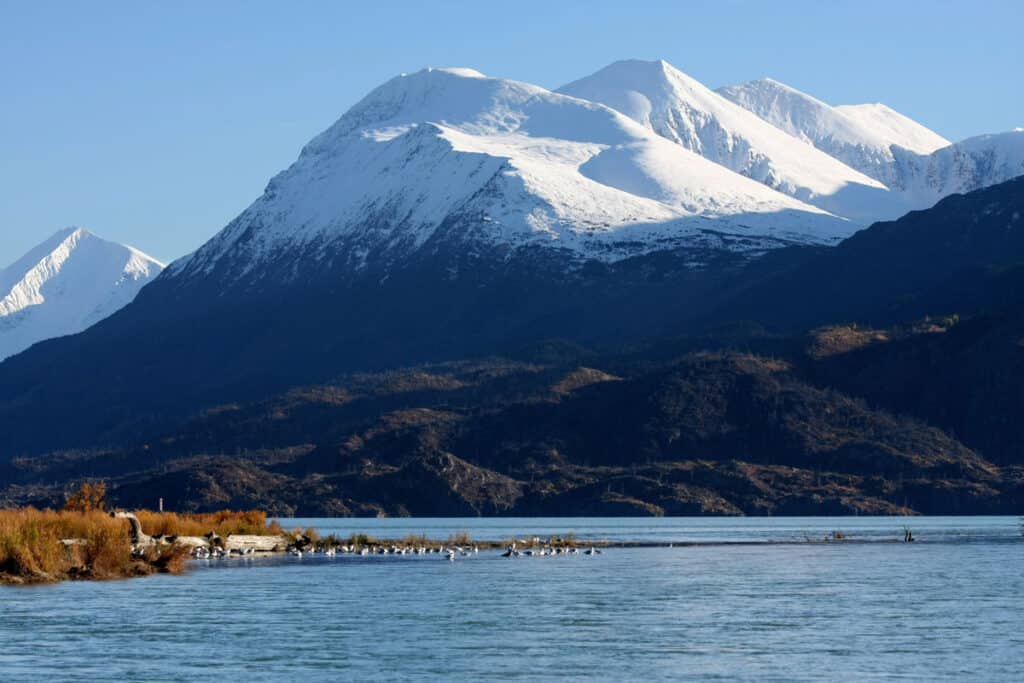
Kenai River, known for great fly fishing, flows into Skilak Lake creating an awesome and beautiful fishing wonderland
©iStock.com/Jonathan Nafzger
| Skilak Lake | |
|---|---|
| Surface Area | 24,711 acres |
| Max Depth | 528 feet |
- Camping/Overnight Available: Yes
- Boating/Docks Available: Yes
- Swimming Permitted: Not recommended
- Fishing Permitted: Yes
- Best For: Nearby Kenai River, High Winds & Dangerous Waters
The Kenai River flows into Skilak Lake which results in some of the best fly fishing in the state. The lake also produces some amazing fishing. Many anglers target the river and fly fishing but the lake is also excellent for those in the know.
Mammoth size king salmon, massive rainbow trout, and beautiful dolly varden are pulled from the waters of the Kenai River. Sockeye salmon, silver salmon, pink salmon, dollies, and rainbows swim Skilak Lake.
The lake is known to have dangerous conditions for boating so be sure to double-check the rules and regulations before visiting. Families have been rescued from the lake so boaters should really take extra precautions.
Alaska’s Famous Photography Lake
9. Lake Clark

The remote location of Lake Clark makes it the perfect location for serious anglers to catch a wide variety of great sport fish
©iStock.com/Alexei Perelygin
| Lake Clark | |
|---|---|
| Surface Area | 81,920 acres |
| Max Depth | 1,056 feet |
- Camping/Overnight Available: Yes
- Boating/Docks Available: No
- Swimming Permitted: Not recommended
- Fishing Permitted: Yes
- Best For: Outdoor Photo Opps, Amazing Fishing
The majestic scenery of Lake Clark provides photo opportunities available nowhere else in the world. It’s been referred to as the “essence of Alaska” because all the different geographical aspects of Alaska are represented in this single place.
Serious anglers can expect to pull char, dolly varden, grayling, pike, rainbows, salmon, and lake trout from the pristine waters of Lake Clark. You’ll want to pencil in your arrival to the lake around July or August to maximize your fishing experience. Guides are available and recommended to really make it a bucket list fishing extravaganza.
The lake is isolated and mostly accessible by plane. There are plenty of options to get there and decent lodging options when you arrive. Lake Clark is the seventh-largest lake in Alaska so there are endless places to explore, photograph and fish.
Does Alaska Have a Lake Monster?
10. Iliamna Lake
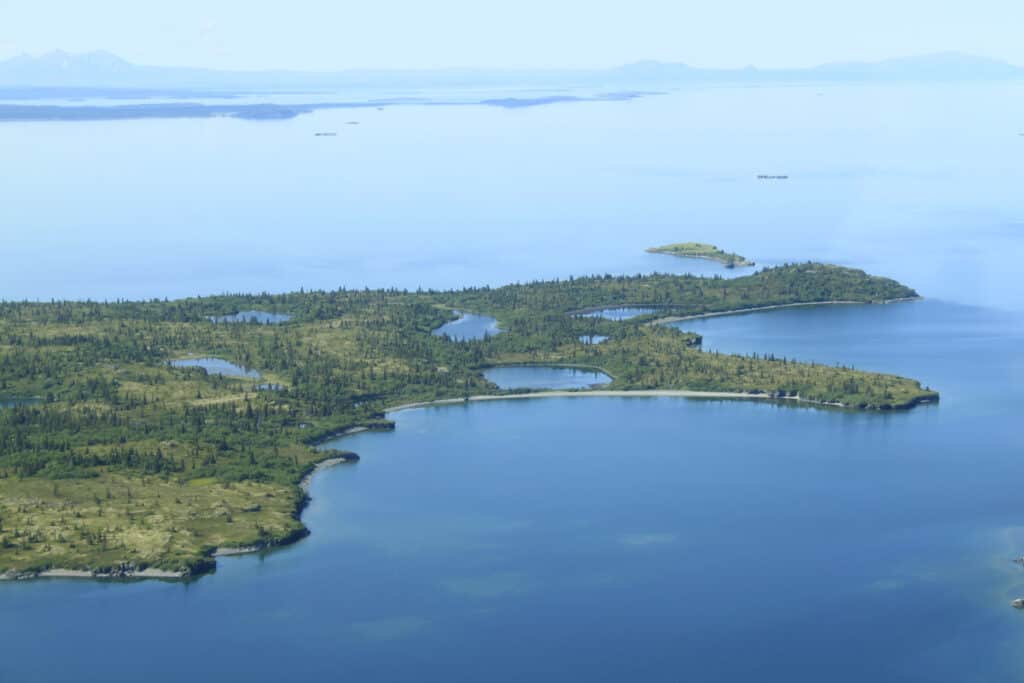
Alaska’s own version of Nessie named Illie is said to inhabit the waters of Iliamna Lake. A giant, ancient creature said to kill warriors; yikes!
©Nessie91/Shutterstock.com
| Iliamna Lake | |
|---|---|
| Surface Area | 640,000 acres |
| Max Depth | 988 feet |
- Camping/Overnight Available: Yes (Access by plane only)
- Boating/Docks Available: No
- Swimming Permitted: Yes
- Fishing Permitted: Yes
- Best For: Animal Planet River Monsters Hunt for the lake monster “llie”
There are actually two monsters at Iliamna Lake, one is called Ilie and the other is the lake itself. Spanning one-thousand and twelve square miles and reaching a maximum depth of nine hundred and eighty-eight feet, the lake is quite literally monstrous. It’s the eighth-largest lake in the United States and when first discovered considered a small sea.
The Anchorage Daily News once offered a one hundred thousand dollar reward to anyone who could prove the existence of the lake monster. So far no one has been able to come up with concrete evidence to claim the bounty. Some pretty convincing stories and photos do exist and there are many theories about what the creates actually might be; some have said white sturgeon or Pacific sleeper shark.
There are other things to do at the lake besides search for the elusive lake monster. Fishing for trout, salmon, and grayling is very popular. Autumn months are considered best for landing gigantic rainbow trout. Access to the lake is primarily through air and water so plan accordingly!
The photo featured at the top of this post is © iStock.com/Jonathan Nafzger
Thank you for reading! Have some feedback for us? Contact the AZ Animals editorial team.






